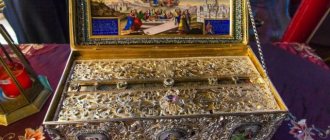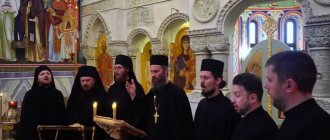Why is the word “rejoice” constantly repeated in akathists?
Hieromonk Job (Gumerov)
As a genre of Christian hymnography, the akathist (from the Greek
akathistos
; where
a
is a negative particle,
kathizein
- sit; lit. “unsaddled”) is distinguished not only by its construction, but by its special joyful mood.
This is explained by the real circumstances under which the first akathist was created. It was composed in honor of the Mother of God and was sung all night while standing on Saturday, the fifth week of Lent, after the victory over the Persians and Avars who besieged Constantinople led by the commander Shah Khozroy Sarvar in 626. The capital was surrounded by sea and land. The situation was hopeless. The Mother of God showed miraculous help, and the city was saved (“To the chosen victorious Voivode, as if we had got rid of the evil ones, let us sing thanksgiving to Thy servants, the Mother of God”). In gratitude for this intercession, the Feast of Praise of the Most Holy Theotokos (Saturday of the Akathist) was established. The word “rejoice” repeated many times is taken from the Holy Gospel. This is how the Archangel Gabriel greeted the Mother of God, bringing the news of the future birth of the Messiah from Her: “Rejoice
, O Blessed One! The Lord is with You; Blessed are You among women” (Luke 1:28). The akathists dedicated to saints, created on the model of the first akathist, also contain a repeated call to “Rejoice.” The Gospel also provides the basis for this. The saints, through the feat of faith and life, were worthy of the reward about which the Savior speaks in the Beatitudes: “Rejoice and be glad, for great is your reward in heaven” (Matthew 5:12).
Tradition attributes the compilation of the akathist to the Mother of God to the deacon of the great Church of Constantinople, George of Pisidia. At first, the service was performed only in the Blachernae Church of Constantinople, where the miraculous image of the Mother of God “Hodegetria” was located. ,
as well as the chasuble and belt of the Mother of God. But in the 9th century, the Feast of the Praise of the Most Holy Theotokos was included in the Typik of the monasteries - Studite and St. Savva the Sanctified, and then in the Lenten Triodion. So this special holiday became universal throughout the Orthodox Church.
Apart from Saturday of the fifth week of Great Lent, akathists in honor of the Savior, the Mother of God and the saints are usually read outside of fasting, during which Christians should strictly pray for the forgiveness of their sins.
We most often turn to akathists at times of special joy and gratitude, or when we need to ask the Lord and the Mother of God for help in difficult circumstances. April 4, 2021
Akathist
AKATHIST - from the Greek word “ἀχἀθιστος” (lit. unseated) this is the name of chants of praise in honor of the Lord Jesus Christ, the Mother of God and the saints, performed by those praying while standing (hence the name). The most ancient akathist and at the same time the original for all others is considered the Akathist to the Mother of God. It consists of 25 separate chants: 13 kontakia and 12 ikos. Starting from the first ikos, the chants are arranged in the order of the Greek alphabet, i.e. the first ikos begins with alpha, the second kontakion twisted, etc. until the last kontakion with omega. The first kontakion begins with the term τη, which makes it stand out from the general account, that is, from the entire sum of the letters of the Greek alphabet. Likewise, it alone ends with the welcoming exclamation: “Rejoice,” but not “Alleluia,” like the other 12 kontakia. The content of the kontakia is divided into two parts: in the first part, up to the 7th kontakion, the historical content predominates, in the second part, from the 7th kontakion, the dogmatic content predominates. The volume of the Ikos is three times larger than the kontakia that preceded them. The first third of each ikos, equal to the kontakion, contains, like the kontakia, a brief mention of significant events at the Annunciation of the Mother of God, during the adolescence of the Savior, and mainly depicts the extraordinary and saving influence of the incarnation of Jesus Christ on us. The remaining two thirds of the ikos consist of 12 invocations: “Rejoice” (χαἱρε). This greeting from the angel of good news is each time accompanied by various majestic names of the highest perfections of the Most Pure Virgin, welcoming surprises at Her greatness before God, prayerful exclamations and a calculation of the extraordinary benefits bestowed by her on all believers. These greetings, or doxologies, beginning with the word: “Rejoice,” are arranged in the ikos in six pairs, and the couplets usually have the same number of syllables in each pair. In a significant part of the greetings, the akathist repeats the hymns of Ephraim the Syrian (VI century) in honor of the Mother of God. For example, the akathist says: “Rejoice, with it the oath will disappear” (1 Ik.), in Ephraim - “Rejoice, redemption from the oath”; in the akathist: “Rejoice, Bridge, lead those who are from earth to heaven, Rejoice, heavenly ladder, with which God descended,” (Ik. 2), in Ephraim: “the bridge of the whole world, leading to heaven,” “Rejoice, ladder, according to which angels descend"; in the akathist: “Rejoice, blessed-leaved tree, with it many are covered” (Ik. 7), in Ephraim: “Rejoice, blessed-leaved tree, from it they gather fruit”; in the akathist: “Rejoice, God is the inconceivable container” (ic 8), in Ephraim: “Mary embraces the inconceivable God”; in the akathist: “Rejoice, praise of the priests” (Ik. 12), in Ephraim “Rejoice, praise of the apostles”; in the akathist: “Oh, all-sung Mother,” in Ephraim: “Oh, all-sung Mother of God.” Some of the greetings. for example: “Rejoice, pillar of virginity”, “Rejoice, door of salvation”, “Rejoice, bride-dyeer of the souls of the saints” (Ik. 10), “Rejoice, lightning that enlightens souls” (Ik. 11), borrowed from the words of John Chrysostom on Annunciation (Makarevsky Cheti-Minea, l. 602, 604, 616). Even the final greeting to the ikos: “Rejoice, Unmarried Bride,” is borrowed from the kontakia for the Annunciation of Roman the Sweet Singer.
A special group consists of greetings containing indications of events contemporary to the writing of the akathist and thereby making it possible to determine the reason for its composition. Thus, according to the testimony of the first kontakion, the akathist was written on the occasion of the Mother of God’s deliverance of Constantinople from the invasion of some enemies: songs of thanksgiving and victory to the Mother of God are lifted up in it on behalf of her city; by which name it began to be called from the 6th century. Constantinople. We find more precise indications of this event in 5 ikos. Based on the data it contains, it can be judged that the author means the era of Heraclius (610-640). Thus, he notes the death of his predecessor Phocas, who marked his reign with a series of murders (“Rejoice, thou who cast out the inhuman tormentor from the authorities”), and the destruction by Heraclius of the temple of fire worshipers in Armenia in 624 (“Rejoice, thou who extinguished the worship of fire”). The akathist does not make any reference to the reign of subsequent emperors, and therefore one might think that by the invasion of Constantinople by enemies he means the siege of this city under Heraclius. This conclusion could not be more confirmed by the fact that in some of the oldest manuscripts of the akathist the enemies are called Persians. Instead of the usual greeting: “Hail, guide of the faithful to chastity” in Greek manuscripts of the 9th and 10th centuries, in Slavic Kondakaria of the 11th century. Syn. Bible No. 319 reads: “Hail, guide of the Persians to chastity” ('Εχχλησιαστιχἡ ἁλἡθελα 1892 395. Kondakaria in the Greek original of the 12th-13th centuries. p. 16. 1879. Work by Archim. Amphilochius ). It is known from history that the Persians, in alliance with the Avars, besieged Constantinople only under Heraclius (in 626); two later attacks (in 673 and 717) were carried out not by them, but by the Arabs. With the timing of the akathist to coincide with the siege of Constantinople by the Persians, such a greeting of the fifth ikos as: “Rejoice, you who deliver from barbarian (in the Greek Kondakaria of the 12th-13th centuries and Slavic of the 11th century “from many-divine”) idolatry becomes understandable. It represents gratitude to the Mother of God for deliverance from the violent introduction of idolatry, which was threatened by the leaders of the Avars and Persians - Khan Bayan and Sarvor. To all the proposals of the citizens of Constantinople, the first said one thing: “I and my friend will not make any peace with Heraclius until he renounces his crucified God.” Such a demand is inappropriate in the mouths of Arab monotenses, and therefore, with the attribution of the akathist to the siege of Constantinople in 673 and 717 (as does Synaxarion Callista), the mentioned greeting remains inexplicable. In the proud statement of Khan Bayan: “do not delude yourself with hope in God in whom you believe; tomorrow I will certainly take your city and turn it into a desert,” finds its explanation and greeting 6 ikos: “Rejoice, you who have exposed the deceit of idols.” The origin of the akathist and some historical monuments are presented in the same light. These include “Bellum Avaricum” - the work of a contemporary and describer of the siege of 626, George Pisis, and “the story of the unsaddled”. The first, let’s say, is not expressed quite clearly: it simply invites the citizens of Constantinople to sing a solemn hymn in gratitude for the deliverance (Migne, PG 92 p. 1892), but for this the second already directly consider the akathist a song of gratitude to the Mother of God for saving Constantinople from the Avars and Persians . This is the story of the nesedal of the Greek Solemnity of the 10th - 11th centuries. (repeated by Minem, 1353-1372 and in Christ. Reading 1837, Part I, pp. 263-286), the Greek Lenten Triodion of 1460, the Slavic of the same century and the current printed one. According to these stories, repeating with various variations the story of George Pisis and the author of the Easter Chronicle (Min, vol. 92, 1013-1016), while myriads of Avars and Persians surrounded Constantinople on all sides, Patriarch Sergius with icons of the Mother of God, with things not made by hands In the image of the Savior, with the glorious tree of the Cross and an honest robe, he walked around the walls of the city, accompanied by the people, convincing the citizens not to lose heart, prophetically assuring that the Irresistible Intercessor of the city would overthrow the opposition. Encouraged by their successes at the Church of St. Source, citizens increasingly began to make decisive and bold forays. The Avars were repelled and dispersed and, due to the depletion of supplies, began to leave the city in large numbers. Finally, the ships of the enemies, filled with warriors, were defeated at the Blachernae Mother of God by a sudden gusty wind, a great many enemies were swallowed up by the depths of the sea, the death of the enemies was so great that there were not enough living ones to burn the dead. This miraculous liberation was accomplished by the power and mercy of the Blessed Virgin. The people, who witnessed such a decisive destruction of numerous enemies, sang a hymn, standing vigilantly in churches all night long, to their vigilant protector; This hymn is called an akathist - non-sedal.
The solution to the question of the author of the akathist has a completely different character: it is quite difficult to give a strictly defined answer to it. Some assimilate the akathist to Roman the Sweet Singer (Archimandrite Amphilochius. Kondakariy in Greek. XII-XIII centuries, p. 16). But this view is contradicted, firstly, by the fact that Roman’s works represent pure creativity, and in the akathist there are quite a few borrowings (see above); secondly, Roman has noticeably more warmth, while the author of the akathist has more concern for form. Others consider the Akathist to be the work of Sergius, Patriarch of Constantinople, a contemporary of the siege of 626 (Fokkov. On the syntax of the Greek New Testament language and Byzantine, p. 177. Moscow. 1887. Krumbacher. Geschichte der Byzantischen Litteratur. S. 672. Munchen. 1897). One manuscript from the library of St. speaks in favor of their opinion. Mark in Venice: before the akathist there is a remark: “the creation of Sergius, Patriarch of Constantinople.” Without presenting convincing evidence, such a remark is easily explained by the fact that Sergius introduced the akathist, like other chants (for example: “let our lips be filled...” Chronicon Paschale It. p. 714. Corpus Scriptorum Historiae Bysantiae. Bonnae. 1832), in church use. More convincing seems to be the opinion of those who attribute the akathist to another contemporary of the siege of 626 - George Piside (Filaret of Chernigov, Historical Review of the chants and hymn writers of the Greek Church. P. 243. Lovyagin. Liturgical canons in Greek, Slavs, and Russian language p. 192. Pet. 1861 Quercius., in Minya vol. 92, 1334). Both the form of the akathist and the content speak for this. It is written in the same iambic verse and with the same grace as other works of Pisis, and contains the same thoughts that are found in his works “on the creation of the world” and “on the vanity of the world.” This opinion is also favored by the fact that greetings beginning with the Archangel’s invocation: “Rejoice” are found in Pisis in “Bellum Avaricum”. Compiled in the 7th century. and originally performed in the Blachernae church, the akathist has been introduced since the 9th century. in the charter as an integral part of the divine service on Saturday of the fifth week of Lent, and the memory of the liberation of Constantinople is celebrated on August 7 (Mesyacheslov under the Greek Gospel. IX century. Sergius. Complete Months of the East. II vol. 207 pp.). Under the same date, the Russian Church also remembers this event (Monsyatseslov of the Slavic Mstislav Gospel. XII century, month of the Studio charter of the XII century. Complete Months of the East I vol. Appendix. pp. 17, 35). In the Monthly Book of the most ancient Slavic prologue (XII century), representing the first edition of the Greek Monthly Book of Emperor Basil, the legend about this event itself is placed under August 7 (Full Month. East. I vol. pp. 242-254; appendices p. 166) . From the same centuries, an indication of the reading of the akathist on Saturday of the fifth week of Lent has been preserved (Studio charter according to the manuscript of the 12th-13th centuries. Moscow Syn. Bible. 380, 17; hand. Soph. Bible. No. 1136 l. 7, volume Odintsov The order of public and private worship in other Russia until the 16th century pp. 43, 34), and in the manuscripts of the Jerusalem charter XV-XVI we find a statement of the order that was observed during the reading of the akathist. (Dmitrievsky. Divine services in the Russian church in the 16th century. pp. 20-204. Kazan. 1884). Both in this and in the later period, the usual language of the akathist is the liturgical Slavic language, and only in 1855 it was translated into Russian by the late Metropolitan of Moscow Philaret (Additions to the works of the Holy Father. XIV. p. 139).
The Akathist to the Mother of God served as the original for all the others (Kiev edition of Akathists, 1703). Based on his model, such currently known akathists were compiled, such as St. Nicholas the Wonderworker, the Sweetest Jesus, the Dormition of the Mother of God, John the Baptist, St. Peter and Paul, Archangel Michael, the Ethereal Powers and All Saints. The first of them, i.e., the akathist to St. Nicholas the Wonderworker, is considered the work of the Patriarch of Constantinople Isidore Bucharis (1341 - 1349). With his name, it is placed in the Slavic Psalter, written by the Greek Ignatius in 1430, in the canon of Cyril of Belozersky in 1407 (Filaret Historical review of hymns. p. 446) and in the service to St. Nicholas on May 9 according to the manuscript of Count Uvarov No. 341 ( Monuments of ancient writing, c. LXXII). The modern edition of this akathist presents quite a few features in comparison with the ancient one - Ignatius. Appearing for the first time in the Kiev edition of the akathist in 1638, they then moved on to other publications. Akathists to John the Baptist, arch., are signed in the name of the same Isidore. Michael (Psalter of Ignatius, Canon of Cyril of Belozersky), Dormition of the Mother of God app. Peter and Paul (canon 1457). As for the author of the akathist to the Sweetest Jesus, it is quite difficult to say anything definite about him. Usually it is taught either to the monk of the Studite monastery, Theoktistus (IX), or to John of Euchaitis (XI century). But in the canon attributed to the first to Jesus the Sweetest (Akathistnik Mogilev, ed. 1698 and the Followed Psalter 1475) there is still no akathist, nor was there one at the time when John the Euchaite wrote the canon to Jesus (Filaret ibid.). In the Kiev edition of the akathists of 1697 and in the Mogilev edition of 1698, there is, among other things, an akathist to the Holy Sepulcher and the Resurrection, but it is condemned by the Regulations on the grounds that the church rejoices in the resurrection of Christ, and does not perform prayers of repentance.
* Alexander Vasilievich Petrovsky, Master of Theology, teacher at St. Petersburg Theological Seminary.
Source of text: Orthodox Theological Encyclopedia. Volume 1, column. 374. Petrograd edition. Supplement to the spiritual magazine “The Wanderer” for 1900.
Text taken from: Orthodox online library “Patristic Heritage”
Water Blessing Moleben and Vespers with Akathist, what is it?
Water-blessing prayer with akathist, what is it? Holy water is another equally important symbol of Christianity. And often she is consecrated precisely in such prayer services, while reading songs in which they address the Lord and the Most Pure One.
People ask to give them grace and peace, to send down peace and joy. They are usually performed by church ministers at the request of those in need. After the ceremony, everyone who ordered a prayer service can take the blessed water with them.
The best article for you, go to: Following to Holy Communion. Canons for Holy Communion
Traditional Orthodox Vespers are also read with prayers. There are simple and festive vespers, they differ in their structure. They take place around nine o'clock in the evening. And during each, songs are necessarily performed in which the Almighty and his deeds on Earth are praised.
Akathist is a prayer, an eternal and imperishable song of the heart. It contains traditions and history, the culture of the formation of Orthodoxy as a world religion. And every believer graciously honors it and keeps it in his soul as the most precious treasure.
The Lord is always with you!
In the dictionary Complete accentuated paradigm according to A. A. Zaliznya
rejoice, rejoice, rejoice, rejoice, rejoice, rejoice, rejoice, rejoice, rejoice, rejoice, rejoice, rejoice, rejoice, rejoice, rejoicing, rejoicing, rejoicing, rejoice rejoicing, rejoicing, rejoicing, rejoicing, rejoicing, rejoicing, rejoicing, rejoicing, rejoicing, rejoicing, rejoicing, rejoicing, rejoicing, rejoicing, rejoicing, rejoicing, rejoicing, rejoicing, rejoicing, rejoicing, rejoicing, rejoicing, rejoicing, rejoicing, rejoicing, ra rejoicing, rejoicing, rejoicing, rejoicing, rejoicing, rejoicing, rejoicing, rejoicing, rejoiced, rejoiced, rejoiced, rejoiced, rejoiced, rejoiced, rejoiced, rejoiced, rejoiced, rejoiced, rejoiced, rejoiced, rejoiced, rejoiced, rejoiced, rejoiced rejoiced, rejoiced, rejoiced, rejoiced, rejoiced, rejoiced, rejoiced
Share the meaning of the word:
In the Dictionary of Synonyms
have fun, triumph, celebrate, enjoy, be delighted, rejoice, be in (delight, admiration), (be, feel) in seventh heaven, be delighted, melt from (delight, admiration), be overwhelmed with joy, it’s like angels are singing in the soul, the heart (jumped, leaped), the bones began to play, (legs, earth) (under oneself) not to hear, to be consoled, little one, to amuse oneself, not to hear one’s feet under oneself for joy, to drag oneself, not to hear one’s feet, to jump like a goat, not to hear one’s feet under oneself , feel in seventh heaven, be in seventh heaven, radekhonek, not enough, be happy, glad-radeshenek, radekhonek, fuck, shine like a brand new fifty-kopeck piece, look like a birthday boy, shine, have fun, rejoice, not feel your feet, the earth under you not to hear, not to hear the ground beneath you, not to remember yourself with joy, the soul jumped up, to experience joy, not to feel your feet under you, not to hear your feet under you, to worship God, not to feel your feet under you with joy, to have fun, not to feel your feet under you for joy, to rub your hands, not to hear the ground beneath you, to crap, to have fun, to sing
Song of praise to the Mother of God
Akathist to the Most Holy Theotokos is a mandatory prayer to the “Chosen Voivode...”, which is read on the Saturday of Praise of the Blessed Virgin Mary and the only one that can be performed during the days of Great Lent.
The best article for you, go to: Prayer before reading the Gospel
Songs calling for help in various everyday adversities are sung to the icons of the Mother of God, each of which has its own meanings, in particular:
- icon “The Queen of All”: healing from cancer, various addictions, passion for occult phenomena;
- “Education”: prayers of parents for their children;
- “Mammal Nurse”: assistance during childbirth and raising babies;
- “The Burning Bush”: protection from fire, assistance to the innocent in court, family well-being;
- “Inexhaustible Chalice”: help in the fight against alcoholism, smoking and drug addiction;
- “Kazan”: victory over the enemy, Christian marriages, various ailments, mainly eye diseases;
- “Protection of the Most Holy Theotokos”: deliverance from temptations and sins, prayers for peace and grace;
- “Quick to Hear”: immediate healing from all kinds of ailments;
- icon “Quench my sorrows”: help and support in need, sadness and sorrow;
- “Softening Evil Hearts”: about peace between warring parties;
- “Healer”: salvation from all sorts of ailments.
All these icons are very powerful, because they are united by one great force - the Orthodox faith.








